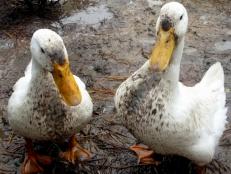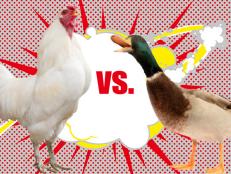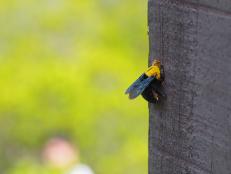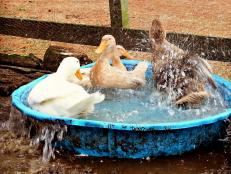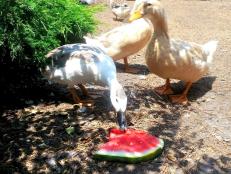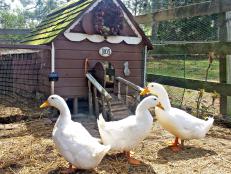Raising Ducks: Caring for Ducklings
Here are a few tips on raising baby ducklings to help you get started.

So, you've decided raising backyard ducks is right for you and you're ready to begin? If that's so, you’re probably wondering exactly how to go about raising ducklings. Here are a few tips to help you get started.
How to Raise Ducklings 9 Photos
Ducklings are about the cutest critter in the barnyard or backyard. Care for your baby ducks with these tips on raising ducklings and watch them grow into easy-to-please members of your family.
What You’ll Need to Raise a Baby Duckling
- Brooder – a spare bathtub, large Rubbermaid tote, dog crate or cardboard box lined with plastic
- Heat Lamp
- Thermometer
- Chick feed — regular (chicken) chick starter feed is fine as long as it is unmedicated
- Brewer’s yeast
- Grit — commercial chick grit or a small dish of coarse dirt
- Shallow bowl for water — such as a sturdy ramekin or soufflé dish
- Shallow bowl for food — a small terracotta planter base works well
I have raised ducklings in a plastic tote, a kiddie pool and a galvanized tub. By far, the best place I have found to brood your ducklings is a spare bathtub, if you have one, with their water dish at the drain end.
Ducklings can’t help but play in their water, and the brooder will be soaking wet all the time no matter what you do. So the bathtub method seems to be the most effective in containing their mess. I line the bathtub with a few layers of newspaper to absorb the water, then lay rubber shelf liner over that so the ducklings won’t slip on the slick newspaper. After the ducklings come to recognize what is food and what isn’t, I add a layer of pine shavings which are replaced as necessary, along with the newspaper and shelf liner.
When you first bring your new ducklings home from the feed store or they arrive in the mail, dip each duckling’s bill into a shallow dish of room-temperature water (or sugar water – 1/3 cup sugar/per gallon water), then set each into your pre-heated brooder. The temperature needs to be 90 degrees for the first week, then lowered a degree a day (7 degrees/per week) until the temperature in the brooder is the same as the outside low temperature, at which time the ducklings can be transferred outside to a predator-proof house/pen. By the time the ducklings are 3-5 weeks old, weather-dependent, they can spend warm, sunny days outside, carefully supervised and protected from predators.
Until the ducks are fully feathered around 7-9 weeks old, they have trouble regulating their body temperature and need heat. Watch the ducklings (as well as the thermometer) to gauge if they are warm enough. Warm ducklings will scamper around the brooder. If they are too cold, they will cluster under the heat source. If they are too warm, they will pant and stand as far from the heat as they can get.
Ducklings hatched in an incubator, unlike those hatched under a mama duck, don’t have oil glands working yet to coat and waterproof their feathers, so they can easily become waterlogged and drown. For this reason, a shallow water bowl should be used for water, one into which they can submerge their entire bill to keep their mucous membranes moist, but not fall into and drown. Stones or marbles can be added to a slightly deeper dish as the ducklings get bigger. Until they are about a month old, ducklings should only be allowed short, supervised swims. I fill a plastic tub with warm water and let them splash around for a few minutes to get used to being in water. I then dry them off and return them to the brooder so they don’t catch a chill.
Feeding Ducklings
Ducklings can be fed regular chick feed. (Be sure it is unmedicated because ducklings eat more than chicks and there is a risk they could over-medicate themselves.) However ducklings have higher niacin requirements than chicks so add a sprinkle of brewer’s yeast on top of their feed to assist in building strong bones. Raw oats can also be slowly added to their feed for added protein and nutrients until a 25% oats/75% feed ratio is achieved. Grit in the form of commercial chick grit or coarse dirt must also be provided to help the ducklings digest their food.
Healthy treats such as dandelion greens, chopped grass and weeds (chemically untreated), worms, Swiss chard, kale, peas and moistened oatmeal are all favorites of growing ducklings. Ducks don’t like to eat wilted or trampled greens, so I toss the treats right into their water bowl where they enjoy scooping them up with their bills.
When they eat, ducklings grab a bill full of feed and then dunk it in water to moisten and swallow. Their feed will get wet and should be thrown out daily. Wet feed can harbor mold and bacteria, especially in the warm environment of the brooder. I use a terracotta planter base for feed. The porous material wicks moisture away from the feed and seems to keep it drier. It is also a good idea to place their feed under the heat lamp, where the heat will dry it a bit. I provide constant feed and water for ducklings. Once they are about two months old and presumably living outside, you can remove their feed and water at night if you wish. Leaving only water is fine, leaving feed without water is not. Any time they have access to feed they must have water nearby or they can choke.
A week-old duckling will drink about half a gallon of water a week. By the time they are seven weeks old, ducklings drink a half gallon of water a day, so be sure their water is always filled.
Using the bathtub as a brooder also works well because the bathroom door can be securely shut to keep the ducklings safe from curious children and family pets. If you don’t have a place you can locate your brooder behind a closed door, consider using something you can cover to keep the ducklings safe. Children need to be taught to handle the ducklings carefully and gently, preferably only with adult supervision, and to not drop them.
Handle your ducklings as often as you can. Talk to them and bring them treats, and soon you will have them literally eating out of your hand!
More on Raising Ducks
Popular Duck Breeds
See these suggestions for friendly, attractive ducks that lay well and aren’t too noisy.
Give Backyard Ducks a Home 13 Photos
Build a house for ducks that will keep them happy and healthy with these tips.
Raising Ducks or Chickens?
10 reasons why raising ducks might be a better choice










